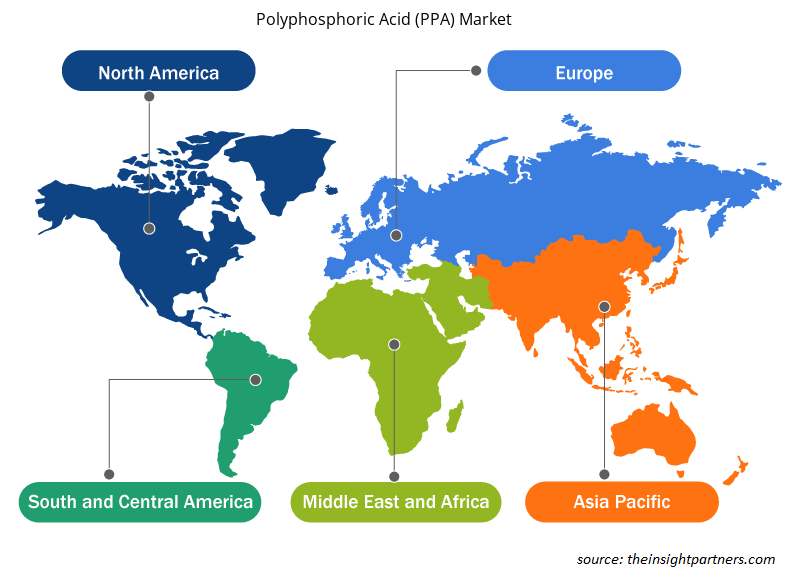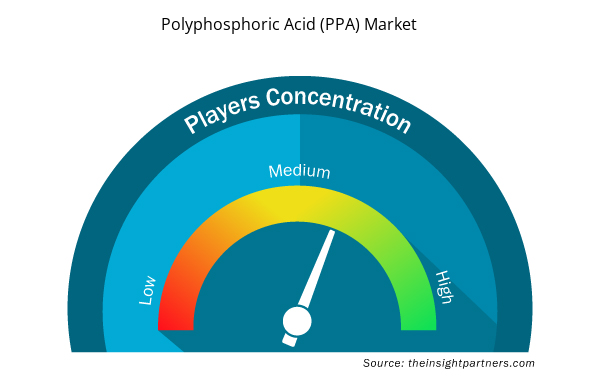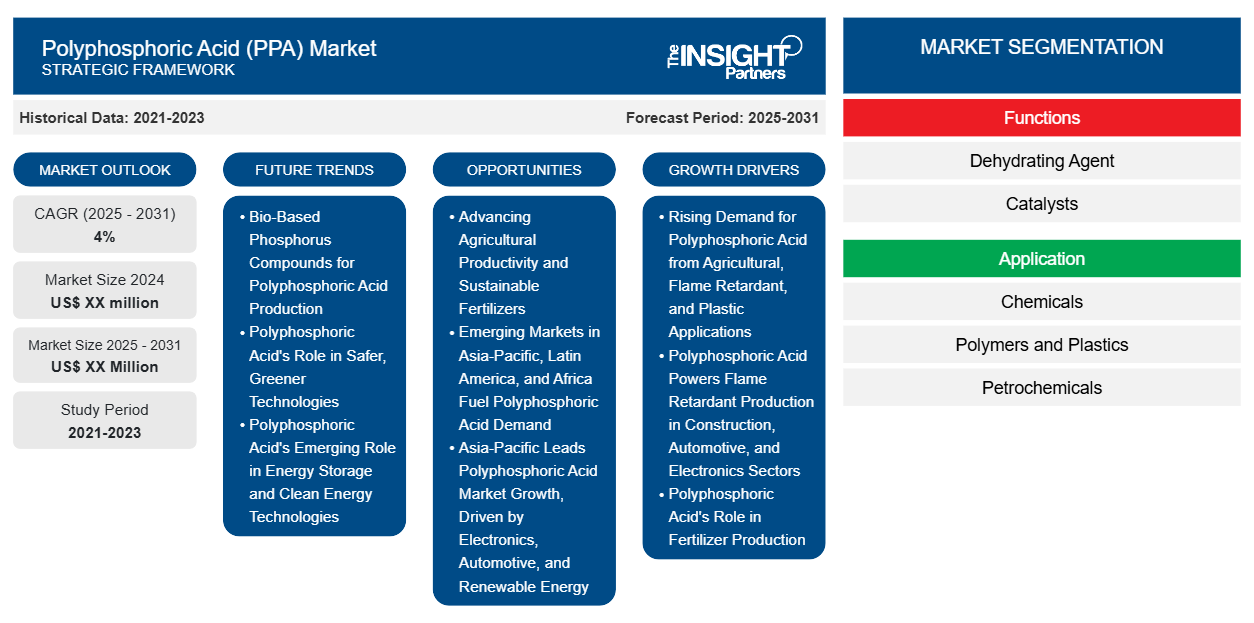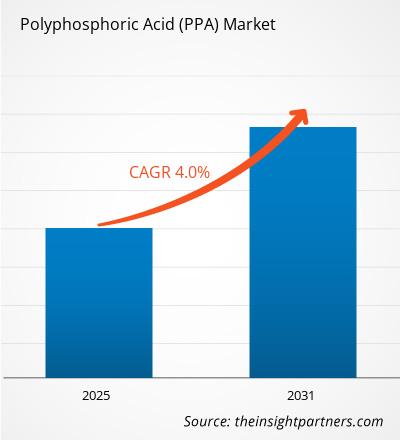Der Markt für Polyphosphorsäure (PPA) wird voraussichtlich von 2024 bis 2031 eine durchschnittliche jährliche Wachstumsrate (CAGR) von 4 % verzeichnen, wobei die Marktgröße von XX Millionen US-Dollar im Jahr 2024 auf XX Millionen US-Dollar bis 2031 wachsen wird.
Der Marktbericht für Polyphosphorsäure ist nach Funktionen (Dehydratisierungsmittel, Katalysatoren und andere) segmentiert. Der Markt ist nach Anwendung segmentiert (Chemikalien, Polymere und Kunststoffe, Petrochemikalien und andere). Die Marktgröße und -prognose auf globaler, regionaler und Länderebene für alle wichtigen Marktsegmente werden im Rahmen des Berichts abgedeckt. Der Bericht bietet den Wert in USD für die oben genannte Analyse, Segmente, Regionen und Länder. Der Bericht deckt Markttrends sowie Marktdynamiken wie Treiber, Beschränkungen und wichtige Chancen ab. Der Bericht deckt auch die Branchenlandschaft und Wettbewerbsanalyse ab, einschließlich Marktkonzentration, Heatmap-Analyse, prominenten Akteuren und jüngsten Entwicklungen auf dem Markt.
Zweck des Berichts
Der Bericht „Markt für Polyphosphorsäure (PPA)“ von The Insight Partners soll die aktuelle Situation und das zukünftige Wachstum sowie die wichtigsten treibenden Faktoren, Herausforderungen und Chancen beschreiben. Dies wird verschiedenen Geschäftspartnern Einblicke geben, wie zum Beispiel:
- Technologieanbieter/-hersteller: Um die sich entwickelnde Marktdynamik zu verstehen und die potenziellen Wachstumschancen zu kennen, damit sie fundierte strategische Entscheidungen treffen können.
- Investoren: Durchführung einer umfassenden Trendanalyse hinsichtlich der Marktwachstumsrate, der finanziellen Marktprognosen und der Chancen entlang der Wertschöpfungskette.
- Regulierungsbehörden: Zur Regulierung von Richtlinien und Überwachungsaktivitäten auf dem Markt mit dem Ziel, Missbrauch zu minimieren, das Vertrauen der Anleger zu bewahren und die Integrität und Stabilität des Marktes aufrechtzuerhalten.
Polyphosphorsäure (PPA) Marktsegmentierung
Funktionen
- Entwässerungsmittel
- Katalysatoren
Anwendung
- Chemikalien
- Polymere und Kunststoffe
- Petrochemie
Passen Sie diesen Bericht Ihren Anforderungen an
Sie erhalten kostenlos individuelle Anpassungen an jedem Bericht, einschließlich Teilen dieses Berichts oder einer Analyse auf Länderebene, eines Excel-Datenpakets sowie tolle Angebote und Rabatte für Start-ups und Universitäten.
- Holen Sie sich die wichtigsten Markttrends aus diesem Bericht.Dieses KOSTENLOSE Beispiel umfasst eine Datenanalyse von Markttrends bis hin zu Schätzungen und Prognosen.
Wachstumstreiber auf dem Markt für Polyphosphorsäure (PPA)
- Steigende Nachfrage nach Polyphosphorsäure aus landwirtschaftlichen, flammhemmenden und Kunststoffanwendungen: Polyphosphorsäuren werden als wichtige Zwischenprodukte in der chemischen Industrie verwendet und bilden eine Vielzahl von phosphatbasierten Chemikalien wie Organophosphate und Flammschutzmittel. Die wachsenden Bedenken hinsichtlich der Beschaffung hochwertiger Chemikalien in Sektoren wie beispielsweise Landwirtschaft (Düngemittel, Pestizide), Flammschutzmittel und Kunststoffanwendungen sind die treibenden Kräfte des Marktes für Polyphosphorsäure. Darüber hinaus wird erwartet, dass die Nachfrage aus Schwellenländern wächst, da die Industrialisierung in andere Teile der Welt vordringt. In diesem Zeitraum wird erwartet, dass die Nachfrage nach PPA in diesen Anwendungen weiter steigt und so zum Marktwachstum beiträgt.Polyphosphoric Acid from Agricultural, Flame Retardant, and Plastic Applications: Polyphosphoric acids are used as important intermediates in the chemical industry building a myriad phosphate-based chemicals such as organophosphates and flame retardants. The growing concerns of obtaining quality chemicals in sectors that include but are not limited to agriculture (fertilizers, pesticides), flame retardants, and plastic applications are the wants driving the market for polyphosphoric acid. Further, the demand from emerging economies is anticipated to grow as industrialization expands into other parts of the world. It is during this period that the demand for PPA in these applications is expected to keep on increasing, thus contributing to market growth.
- Polyphosphorsäure treibt die Produktion von Flammschutzmitteln in den Bereichen Bau, Automobil und Elektronik voran: Flammschutzmittel werden bei der Herstellung von Produkten in verschiedenen Branchen wie Bau, Automobil, Textilien und Elektronik verwendet, um Produkte weniger entflammbar zu machen. Polyphosphorsäure ist zu einem wichtigen Rohstoff bei der Herstellung von Flammschutzmitteln wie Phosphatestern geworden. Die Zahlen zur Nachfrage nach diesen feuerhemmenden Materialien sind angesichts zunehmender Bedenken hinsichtlich des Brandschutzes und strengerer Vorschriften in diesem Bereich gestiegen. Daher wird erwartet, dass die Nachfrage nach PPA steigen wird, da Sicherheitsprobleme in der Bau- und Elektronikbranche immer wichtiger werden. Acid Powers Flame Retardant Production in Construction, Automotive, and Electronics Sectors: Flame retardants are used in making products from different industries including construction, automotive, textiles, and electronics, to make products less flammable. Polyphosphoric acid has become a key raw material in the production of flame retardants like phosphate esters. The figures with respect to demand for these fire retardant materials have been on a growth trend in the midst of heightened concerns regarding fire safety and stricter regulations that would relate to this area. Demand is, therefore, expected to increase for PPA with safety issues becoming more pertinent in the construction and electronics industries.
- Die Rolle von Polyphosphorsäure in der Düngemittelproduktion: Polyphosphorsäure wird auch zur Herstellung einer Vielzahl von Düngemitteln verwendet, im Allgemeinen Flüssigdünger und Bodenverbesserer. Die globale Nahrungsmittelproduktion muss mit dem Bevölkerungswachstum Schritt halten, weshalb eine hohe Nachfrage nach hochwertigen Düngemitteln besteht. PPA ist eine wichtige Chemikalie für die Herstellung von phosphorbasierten Düngemitteln, die eine wichtige Rolle bei der Steigerung der landwirtschaftlichen Produktion spielen. Die Agrarindustrie, die in Regionen wie dem asiatisch-pazifischen Raum, Lateinamerika und Afrika nicht nur breiter, sondern auch tiefer wird, wird weiterhin das Wachstum der Marktnachfrage nach Polyphosphorsäure vorantreiben, da sie die Effizienzsteigerung der Düngemittel am meisten steigert. Acid's Role in Fertilizer Production: Polyphosphoric acid is also used in making a variety of fertilizers generally liquid fertilizers and soil conditioners. Global food production should keep pace with the population increase, which is why there has been a high demand for quality fertilizers. PPA is an important chemical for the manufacture of phosphorus-based fertilizers, which play a significant role in increasing agricultural production. Becoming not only wider but also deeper in regions such as Asia Pacific, Latin America, and Africa, the agricultural industry will continue to drive market demand growth for polyphosphoric acid because of fertilizer efficiency improvement it brings the majority.
Zukünftige Trends auf dem Markt für Polyphosphorsäure (PPA) Acid (PPA) Market Future Trends
- Biobasierte Phosphorverbindungen für die Produktion von Polyphosphorsäure: Die wachsende Bedeutung von Nachhaltigkeit erfordert, dass viele Agenturen der Forschung nach biobasierten und umweltfreundlichen Alternativen zu traditionellen chemischen Prozessen mehr Aufmerksamkeit widmen. Der wichtige Trend, den der Markt für Polyphosphorsäure im Zuge dieser Entwicklungen beobachtet, ist, dass Forscher biobasierte Phosphorverbindungen als nachhaltigere Alternativen erforschen und entwickeln. Ihre Arbeit konzentriert sich auf die Steigerung der Effizienz der Phosphorrückgewinnung und die Entwicklung umweltfreundlicherer Verarbeitungswege für die Produktion von PPA. Eine solche Bewegung hin zu biobasierten Alternativen würde dem zukünftigen Markt für Polyphosphorsäure mit ziemlicher Sicherheit eine neue Form geben, da Hersteller und Industrie planen, den ökologischen Fußabdruck wirklich umweltfreundlicher zu gestalten.Polyphosphoric Acid Production: The growing emphasis on sustainability necessitates the increasing attention paid by many agencies to research on bio-based and green alternatives of traditional chemical processes. The important trend that polyphosphoric acid market observes through these developments is that researchers are exploring and developing bio-based phosphorus compounds for more sustainable alternatives. Their work focuses on increasing the efficiency of phosphorus recovery and developing greener processing routes for production of PPA. Such a movement toward bio-based alternatives would almost certainly put a new shape on the future polyphosphoric acid market, as manufacturers and industries plan on really greening out the environmental foot print.
- Die Rolle von Polyphosphorsäure in sichereren, umweltfreundlicheren Technologien: Als bemerkenswerter Trend zeichnet sich die starke Nachfrage nach den neuesten Entwicklungen in Flammschutztechnologien und Innovationen ab, unter anderem in Richtung Leistungssteigerung, Effizienz und Umweltverträglichkeit von Flammschutzmitteln. Einer der wichtigsten Bestandteile dieser innovativen Flammschutzmittel ist Polyphosphorsäure, denn aufgrund der immer strengeren Vorschriften zum Brandschutz entwickeln sich neue Anwendungsgebiete für PPA, da hochleistungsfähige, ungiftige und umweltverträgliche Flammschutzmittel entwickelt werden. Der Gesamttrend zu mehr Sicherheit und Effizienz bei Flammschutzmitteln wird dem potenziellen Anstieg von Polyphosphorsäure in spezialisierten Märkten wie der Elektronik-, Automobil- und Baubranche wahrscheinlich weiteren Auftrieb verleihen.
- Die neue Rolle von Polyphosphorsäure in der Energiespeicherung und sauberen Energietechnologien: Dies ist die neuartige prospektive Integration der meisten Polyphosphorsäuren in neue Technologien, darunter Bereiche wie Batterieherstellung und Energiespeicherung. PPA wird bereits in einigen Lithografieprozessen von Lithium-Ionen-Batterien verwendet, um die Funktion und Stabilität der Zellen zu verbessern. Jetzt besteht Druck, die Speicherlösungen für technische Anwendungen zu verbessern, da der Bedarf an sauberer Energie auf der ganzen Welt sowie an Elektrofahrzeugen (EVs) und erneuerbaren Energiesystemen weiter zunimmt. Anwendungen von Polyphosphorsäure für Energiespeichersysteme und weitere neue Energieanwendungen könnten wichtige Wachstumstreiber für die nahe Zukunft sein.
Marktchancen für Polyphosphorsäure (PPA)
- Steigerung der landwirtschaftlichen Produktivität und nachhaltige Düngemittel: Ein in Zukunft deutlicherer Anstieg der Weltbevölkerung würde Polyphosphorsäure enorme Chancen bieten, eine entscheidende Rolle bei der Steigerung der landwirtschaftlichen Produktivität zu spielen. Es wird erwartet, dass die Nachfrage nach Düngemitteln aufgrund des steigenden Bedarfs an Nahrungsmitteln steigen wird. Hocheffiziente Düngemittel, die unter Verwendung von Polyphosphorsäure hergestellt werden, sind ein wesentlicher Bestandteil der modernen Anbaumethoden. Angesichts des Fortschritts in der Landwirtschaft, der sich an Präzisionslandwirtschaftstechniken und nachhaltigen Praktiken messen lässt, würden solche Düngemittel auf Polyphosphorsäurebasis für die Lieferketten der Landwirtschaft weiterhin von zentraler Bedeutung sein, um langfristige Wachstumsaussichten im PPA-Bereich zu gewährleisten.
- Schwellenmärkte im asiatisch-pazifischen Raum, in Lateinamerika und Afrika treiben die Nachfrage nach Polyphosphorsäure an: Schwellenmärkte im asiatisch-pazifischen Raum, in Lateinamerika und Afrika sind die attraktivsten Standorte für Wachstumsmöglichkeiten auf dem Markt für Polyphosphorsäure. Die schnelle Industrialisierung, Urbanisierung und landwirtschaftliche Entwicklung in diesen Regionen erhöhen die Nachfrage nach Chemikalien, Düngemitteln und Flammschutzmitteln stetig. Solche Märkte würden Polyphosphorsäure benötigen, um den lokalen Bedarf in den Bereichen Landwirtschaft, Bau und Elektronik zu decken. Unternehmen, die ihre Produktionskapazitäten erweitert und ihre Lieferkette optimiert haben, um diese Schwellenmärkte einzubeziehen, werden in einer starken Position sein, um von der erhöhten Nachfrage nach PPA zu profitieren.
- Asien-Pazifik führt das Wachstum auf dem Markt für Polyphosphorsäure an, angetrieben von Elektronik, Automobil und erneuerbaren Energien: Asien-Pazifik wird sich voraussichtlich zum wichtigsten Marktgebiet in den Marktsegmenten für Polyphosphorsäure entwickeln, insbesondere angesichts der Vorteile, die Anwendungen in der Elektronik und Automobilindustrie bei Flammschutzmitteln und anderen Spezialchemikalien bieten. Abgesehen davon führt die gestiegene Nachfrage der Verbraucher nach elektronischen oder Automobilkomponenten und verfügbaren Technologien für erneuerbare Energien, wie Elektrofahrzeugen, zu einem erhöhten Bedarf an der Entwicklung leistungsstarker, feuerfester Materialien; Polyphosphorsäure spielt auch eine wichtige Rolle bei der Herstellung dieser Flammschutzmittel für die genannten Branchen. Darüber hinaus eröffnen die zunehmende Verbreitung von Elektrofahrzeugen und die Verbesserung der Batterietechnologie den Herstellern weitere Möglichkeiten durch Anwendungen zur Verbesserung der Batterieleistung und Energiespeicherung.
Regionale Einblicke in den Markt für Polyphosphorsäure (PPA)
Die regionalen Trends und Faktoren, die den Markt für Polyphosphorsäure (PPA) während des gesamten Prognosezeitraums beeinflussen, wurden von den Analysten von Insight Partners ausführlich erläutert. In diesem Abschnitt werden auch die Marktsegmente und die Geografie von Polyphosphorsäure (PPA) in Nordamerika, Europa, im asiatisch-pazifischen Raum, im Nahen Osten und Afrika sowie in Süd- und Mittelamerika erörtert.

- Erhalten Sie regionale Daten zum Polyphosphorsäure (PPA)-Markt
Umfang des Marktberichts über Polyphosphorsäure (PPA)
| Berichtsattribut | Details |
|---|---|
| Marktgröße im Jahr 2024 | XX Millionen US-Dollar |
| Marktgröße bis 2031 | XX Millionen US-Dollar |
| Globale CAGR (2024 - 2031) | 4 % |
| Historische Daten | 2021-2023 |
| Prognosezeitraum | 2025–2031 |
| Abgedeckte Segmente | Nach Funktionen
|
| Abgedeckte Regionen und Länder | Nordamerika
|
| Marktführer und wichtige Unternehmensprofile |
|
Dichte der Marktteilnehmer für Polyphosphorsäure (PPA): Auswirkungen auf die Geschäftsdynamik verstehen
Der Markt für Polyphosphorsäure (PPA) wächst rasant, angetrieben durch die steigende Nachfrage der Endverbraucher aufgrund von Faktoren wie sich entwickelnden Verbraucherpräferenzen, technologischen Fortschritten und einem größeren Bewusstsein für die Vorteile des Produkts. Mit steigender Nachfrage erweitern Unternehmen ihr Angebot, entwickeln Innovationen, um die Bedürfnisse der Verbraucher zu erfüllen, und nutzen neue Trends, was das Marktwachstum weiter ankurbelt.
Die Marktteilnehmerdichte bezieht sich auf die Verteilung von Firmen oder Unternehmen, die in einem bestimmten Markt oder einer bestimmten Branche tätig sind. Sie gibt an, wie viele Wettbewerber (Marktteilnehmer) in einem bestimmten Marktraum im Verhältnis zu seiner Größe oder seinem gesamten Marktwert präsent sind.
Die wichtigsten auf dem Markt für Polyphosphorsäure (PPA) tätigen Unternehmen sind:
- Clariant
- Arkema-Gruppe
- Merck KGaA
- Prasol Chemicals Pvt. GmbH.
- Lanxess AG
Haftungsausschluss : Die oben aufgeführten Unternehmen sind nicht in einer bestimmten Reihenfolge aufgeführt.

- Überblick über die wichtigsten Akteure auf dem Markt für Polyphosphorsäure (PPA)
Wichtige Verkaufsargumente
- Umfassende Abdeckung: Der Bericht deckt die Analyse von Produkten, Dienstleistungen, Typen und Endbenutzern des Polyphosphorsäure (PPA)-Marktes umfassend ab und bietet einen ganzheitlichen Überblick.
- Expertenanalyse: Der Bericht basiert auf dem umfassenden Verständnis von Branchenexperten und Analysten.
- Aktuelle Informationen: Der Bericht stellt durch die Abdeckung aktueller Informationen und Datentrends Geschäftsrelevanz sicher.
- Anpassungsoptionen: Dieser Bericht kann angepasst werden, um spezifische Kundenanforderungen zu erfüllen und die Geschäftsstrategien optimal anzupassen.
Der Forschungsbericht zum Markt für Polyphosphorsäure (PPA) kann daher dabei helfen, die Branchensituation und Wachstumsaussichten zu entschlüsseln und zu verstehen. Obwohl es einige berechtigte Bedenken geben kann, überwiegen die allgemeinen Vorteile dieses Berichts tendenziell die Nachteile.
- Historical Analysis (2 Years), Base Year, Forecast (7 Years) with CAGR
- PEST and SWOT Analysis
- Market Size Value / Volume - Global, Regional, Country
- Industry and Competitive Landscape
- Excel Dataset

Report Coverage
Revenue forecast, Company Analysis, Industry landscape, Growth factors, and Trends

Segment Covered
This text is related
to segments covered.

Regional Scope
North America, Europe, Asia Pacific, Middle East & Africa, South & Central America

Country Scope
This text is related
to country scope.
Frequently Asked Questions
Shift toward sustainable and bio-based alternatives are expected to be the key market trends.
Based on geography, Asia Pacific held the largest share of the polyphosphoric acid market due to the strong growth of the chemicals industry in the region.
Based on application, the chemicals segment is expected to witness the fastest growth during the forecast period.
Increasing demand in the chemicals industry are driving the market growth.
Clariant International Ltd, Lanxess AG, Arkema SA, Israel Chemicals Ltd, Prasol Chemicals Limited, Innophos Holding Inc, SMC Global, Magnum International Inc, Merck KGaA, and Nippon Chemical Industrial CO LTD are the key players operating in the polyphosphoric acid market.
The Polyphosphoric Acid (PPA) Market is estimated to witness a CAGR of 4% from 2023 to 2031
Trends and growth analysis reports related to Chemicals and Materials : READ MORE..
1.Clariant
2.Arkema Group
3.Merck KGaA
4.Prasol Chemicals Pvt. Ltd.
5.Lanxess AG
6.SMC Global
7.Yunnan Tianyao Chemical Co., Ltd.
8.Special Materials Company
9.ICL Group
10.Avanschem Pvt Ltd.
The Insight Partners performs research in 4 major stages: Data Collection & Secondary Research, Primary Research, Data Analysis and Data Triangulation & Final Review.
- Data Collection and Secondary Research:
As a market research and consulting firm operating from a decade, we have published and advised several client across the globe. First step for any study will start with an assessment of currently available data and insights from existing reports. Further, historical and current market information is collected from Investor Presentations, Annual Reports, SEC Filings, etc., and other information related to company’s performance and market positioning are gathered from Paid Databases (Factiva, Hoovers, and Reuters) and various other publications available in public domain.
Several associations trade associates, technical forums, institutes, societies and organization are accessed to gain technical as well as market related insights through their publications such as research papers, blogs and press releases related to the studies are referred to get cues about the market. Further, white papers, journals, magazines, and other news articles published in last 3 years are scrutinized and analyzed to understand the current market trends.
- Primary Research:
The primarily interview analysis comprise of data obtained from industry participants interview and answers to survey questions gathered by in-house primary team.
For primary research, interviews are conducted with industry experts/CEOs/Marketing Managers/VPs/Subject Matter Experts from both demand and supply side to get a 360-degree view of the market. The primary team conducts several interviews based on the complexity of the markets to understand the various market trends and dynamics which makes research more credible and precise.
A typical research interview fulfils the following functions:
- Provides first-hand information on the market size, market trends, growth trends, competitive landscape, and outlook
- Validates and strengthens in-house secondary research findings
- Develops the analysis team’s expertise and market understanding
Primary research involves email interactions and telephone interviews for each market, category, segment, and sub-segment across geographies. The participants who typically take part in such a process include, but are not limited to:
- Industry participants: VPs, business development managers, market intelligence managers and national sales managers
- Outside experts: Valuation experts, research analysts and key opinion leaders specializing in the electronics and semiconductor industry.
Below is the breakup of our primary respondents by company, designation, and region:

Once we receive the confirmation from primary research sources or primary respondents, we finalize the base year market estimation and forecast the data as per the macroeconomic and microeconomic factors assessed during data collection.
- Data Analysis:
Once data is validated through both secondary as well as primary respondents, we finalize the market estimations by hypothesis formulation and factor analysis at regional and country level.
- Macro-Economic Factor Analysis:
We analyse macroeconomic indicators such the gross domestic product (GDP), increase in the demand for goods and services across industries, technological advancement, regional economic growth, governmental policies, the influence of COVID-19, PEST analysis, and other aspects. This analysis aids in setting benchmarks for various nations/regions and approximating market splits. Additionally, the general trend of the aforementioned components aid in determining the market's development possibilities.
- Country Level Data:
Various factors that are especially aligned to the country are taken into account to determine the market size for a certain area and country, including the presence of vendors, such as headquarters and offices, the country's GDP, demand patterns, and industry growth. To comprehend the market dynamics for the nation, a number of growth variables, inhibitors, application areas, and current market trends are researched. The aforementioned elements aid in determining the country's overall market's growth potential.
- Company Profile:
The “Table of Contents” is formulated by listing and analyzing more than 25 - 30 companies operating in the market ecosystem across geographies. However, we profile only 10 companies as a standard practice in our syndicate reports. These 10 companies comprise leading, emerging, and regional players. Nonetheless, our analysis is not restricted to the 10 listed companies, we also analyze other companies present in the market to develop a holistic view and understand the prevailing trends. The “Company Profiles” section in the report covers key facts, business description, products & services, financial information, SWOT analysis, and key developments. The financial information presented is extracted from the annual reports and official documents of the publicly listed companies. Upon collecting the information for the sections of respective companies, we verify them via various primary sources and then compile the data in respective company profiles. The company level information helps us in deriving the base number as well as in forecasting the market size.
- Developing Base Number:
Aggregation of sales statistics (2020-2022) and macro-economic factor, and other secondary and primary research insights are utilized to arrive at base number and related market shares for 2022. The data gaps are identified in this step and relevant market data is analyzed, collected from paid primary interviews or databases. On finalizing the base year market size, forecasts are developed on the basis of macro-economic, industry and market growth factors and company level analysis.
- Data Triangulation and Final Review:
The market findings and base year market size calculations are validated from supply as well as demand side. Demand side validations are based on macro-economic factor analysis and benchmarks for respective regions and countries. In case of supply side validations, revenues of major companies are estimated (in case not available) based on industry benchmark, approximate number of employees, product portfolio, and primary interviews revenues are gathered. Further revenue from target product/service segment is assessed to avoid overshooting of market statistics. In case of heavy deviations between supply and demand side values, all thes steps are repeated to achieve synchronization.
We follow an iterative model, wherein we share our research findings with Subject Matter Experts (SME’s) and Key Opinion Leaders (KOLs) until consensus view of the market is not formulated – this model negates any drastic deviation in the opinions of experts. Only validated and universally acceptable research findings are quoted in our reports.
We have important check points that we use to validate our research findings – which we call – data triangulation, where we validate the information, we generate from secondary sources with primary interviews and then we re-validate with our internal data bases and Subject matter experts. This comprehensive model enables us to deliver high quality, reliable data in shortest possible time.




 Get Free Sample For
Get Free Sample For